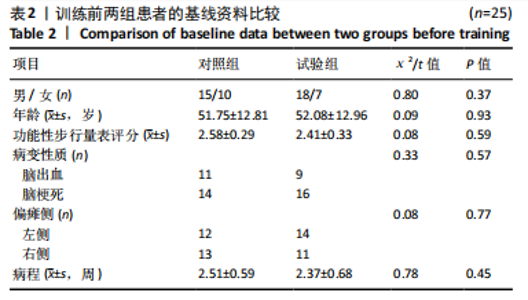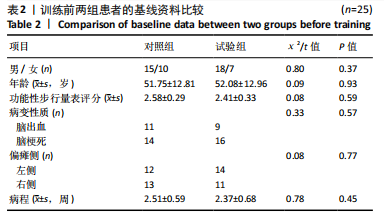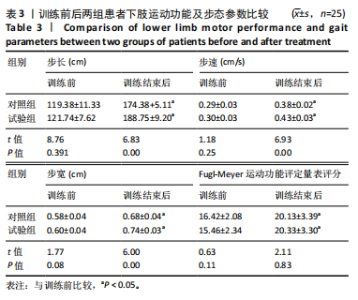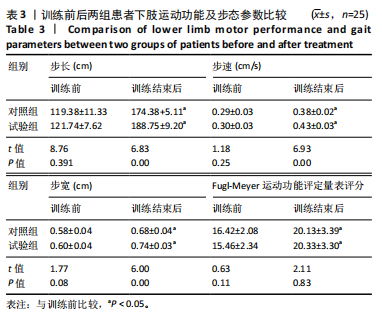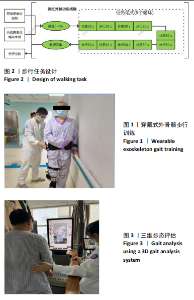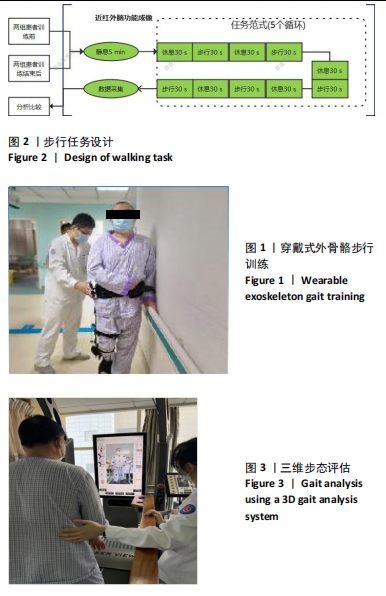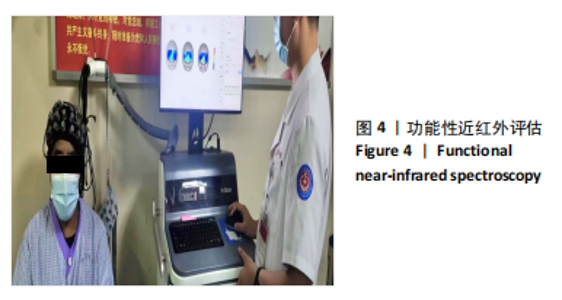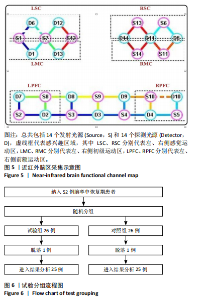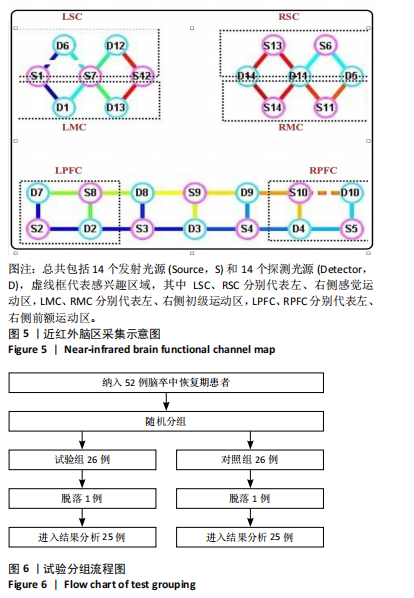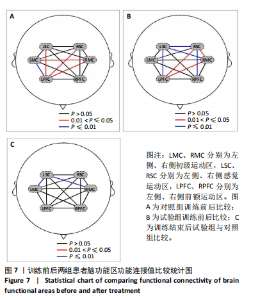Chinese Journal of Tissue Engineering Research ›› 2025, Vol. 29 ›› Issue (24): 5127-5133.doi: 10.12307/2025.757
Previous Articles Next Articles
A wearable exoskeleton with posture feedback improves abnormal gait in patients with stroke
Cao Haijie, Song Huijie, Sun Yalu, Zhang Guangyou, Li Xiang
- Department of Rehabilitation Medicine, Affiliated Hospital of Jining Medical University, Jining 272000, Shandong Province, China
-
Received:2024-07-01Accepted:2024-09-21Online:2025-08-28Published:2025-01-24 -
Contact:Li Xiang, Associate professor, Department of Rehabilitation Medicine, Affiliated Hospital of Jining Medical University, Jining 272000, Shandong Province, China -
About author:Cao Haijie, MS, Technologist-in-charge, Department of Rehabilitation Medicine, Affiliated Hospital of Jining Medical University, Jining 272000, Shandong Province, China -
Supported by:Seedling Project of Affiliated Hospital of Jining Medical University, No. MP-MS-2021-009 (to SHJ)
CLC Number:
Cite this article
Cao Haijie, Song Huijie, Sun Yalu, Zhang Guangyou, Li Xiang. A wearable exoskeleton with posture feedback improves abnormal gait in patients with stroke [J]. Chinese Journal of Tissue Engineering Research, 2025, 29(24): 5127-5133.
share this article
Add to citation manager EndNote|Reference Manager|ProCite|BibTeX|RefWorks
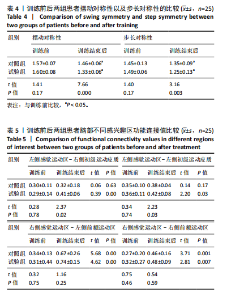
2.5 训练前后两组患者步态对称性比较 训练前,两组患者摆动对称性及步长对称性比较差异均无显著性意义(P > 0.05);训练结束后,两组患者的步长对称性、摆动对称性均较训练前明显改善(P < 0.05),试验组患者摆动对称性、步长对称性优于对照组(P < 0.05),见表4。 2.6 训练前后两组患者脑部不同感兴趣区功能连接值比较 训练前后两组患者脑功能区功能连接值比较,见图7。 训练前,两组患者脑部不同感兴趣区功能连接值比较差异均无显著性意义(P > 0.05);训练结束后,两组患者右侧感觉运动区-左侧前额运动区、右侧感觉运动区-右侧前额运动区功能连接值均高于训练前(P < 0.01),试验组患者左侧感觉运动区-右侧初级运动皮质、左侧感觉运动区-左侧初级运动皮质功能连接值均高于训练前(P < 0.05),试验组患者左侧感觉运动区-右侧初级运动皮质、左侧感觉运动区-左侧初级运动皮质功能连接值高于对照组(P < 0.05),见表5。"
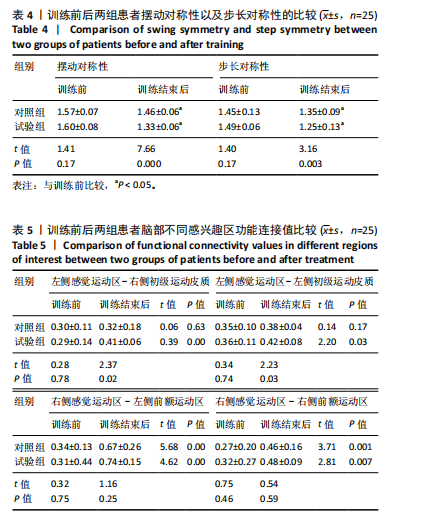
| [1] LIANG Y, SONG Y, WANG L, et al. Research progress on antibacterial activity of medical titanium alloy implant materials. Odontology. 2023;111(4):813-829. [2] WANG W, JIANG B, SUN H, et al. Prevalence, Incidence, and Mortality of Stroke in China: Results from a Nationwide Population-Based Survey of 480 687 Adults. Circulation. 2017;135(8):759-771. [3] COHEN JW, IVANOVA TD, BROUWER B, et al. Do Performance Measures of Strength, Balance, and Mobility Predict Quality of Life and Community Reintegration After Stroke? Arch Phys Med Rehabil. 2018;99(4):713-719. [4] PARK J, KIM TH. The effects of balance and gait function on quality of life of stroke patients. Neuro Rehabilitation. 2019;44:37-41. [5] ZHANG B, WONG KP, KANG R, et al. Efficacy of Robot-Assisted and Virtual Reality Interventions on Balance, Gait, and Daily Function in Patients With Stroke: A Systematic Review and Network Meta-analysis. Arch Phys Med Rehabil. 2023;104(10):1711-1719. [6] SYLVESTER CM, KAPLAN S, MYERS MJ, et al. Network-specific selectivity of functional connections in the neonatal brain. Cereb Cortex. 2023; 33(5):2200-2214. [7] BAI Z, FONG KNK, ZHANG J, et al. Cortical mapping of mirror visual feedback training for unilateral upper extremity: A functional near-infrared spectroscopy study. Brain Behav. 2020;10(1):e01489. [8] LIU Y, LUO J, FANG J, et al. Screening diagnosis of executive dysfunction after ischemic stroke and the effects of transcranial magnetic stimulation: A prospective functional near-infrared spectroscopy study. CNS Neurosci Ther. 2023;29(6):1561-1570. [9] PARK KR, KIM H, SEONG S, et al. A study on the functional near-infrared spectroscopy on impaired prefrontal activation and impulsivity during cognitive task in patients with major depressive disorder. J Affect Disord. 2023;339:548-555. [10] SONG Z, ZHOU Y, ZHENG Y, et al. Factors influencing functional near-infrared spectroscopy in postpartum depression: A cross-sectional study. Int J Gynaecol Obstet. 2023;161(3):1046-1052. [11] MIHARA M, MIYAI I, HATTORI N, et al. Neurofeedback using real-time near-infrared spectroscopy enhances motor imagery related cortical activation. PLoS One. 2012;7(3):e32234. [12] DOBKIN BH. Strategies for stroke rehabilitation. Lancet Neurol. 2004; 3:528-536. [13] RAHMAN MS, PENG W, ADAMS J, et al. The use of self-management strategies for stroke rehabilitation: a scoping review. Top Stroke Rehabil. 2023;30(6):552-567. [14] CALAFIORE D, NEGRINI F, TOTTOLI N, et al. Efficacy of robotic exoskeleton for gait rehabilitation in patients with subacute stroke : a systematic review. Eur J Phys Rehabil Med. 2022;58(1):1-8. [15] CALABRÒ RS, NARO A, RUSSO M, et al. Shaping neuroplasticity by using powered exoskeletons in patients with stroke: a randomized clinical trial. J Neuroeng Rehabil. 2018;15(1):35. [16] YOO M, CHUN MH, HONG GR, et al. Effects of Training with a Powered Exoskeleton on Cortical Activity Modulation in Hemiparetic Chronic Stroke Patients: A Randomized Controlled Pilot Trial. Arch Phys Med Rehabil. 2023;104(10):1620-1629. [17] MOLTENI F, GASPERINI G, GAFFURI M, et al. Wearable robotic exoskeleton for over-ground gait training in sub-acute and chronic hemiparetic stroke patients: preliminary results. Eur J Phys Rehabil Med. 2017;53:676-684. [18] TANG X, WANG X, JI X, et al. A Wearable Lower Limb Exoskeleton: Reducing the Energy Cost of Human Movement. Micromachines (Basel). 2022;13(6):900. [19] 陈瑞旦,黄山城,李天裕.姿势镜对脑卒中后偏瘫患者运动功能障碍恢复的影响[J].深圳中西医结合杂志,2021,31(6):152-154. [20] 中华医学会神经病学分会,中华医学会神经病学分会脑血管 病学组.中国各类主要脑血管病诊断要点2019 [J].中华神经科杂志, 2019,52(9):710-715. [21] 支亮,王玉龙,张清芳,等.脑卒中患者偏瘫步态中的推进力缺陷[J].中国组织工程研究,2024,28(35):5709-5715. [22] CERFOGLIO S, FERRARIS C, VISMARA L, et al. Kinect-Based Assessment of Lower Limbs during Gait in Post-Stroke Hemiplegic Patients: A Narrative Review. Sensors (Basel). 2022;22(13):4910. [23] YAO J, SADO T, WANG W, et al. The Kickstart Walk Assist System for improving balance and walking function in stroke survivors: a feasibility study. J Neuroeng Rehabil. 2021;18(1):42. [24] PARK YH, LEE DH, LEE JH. A Comprehensive Review: Robot-Assisted Treatments for Gait Rehabilitation in Stroke Patients. Medicina (Kaunas). 2024;60(4):620. [25] LIN YN, HUANG SW, KUAN YC, et al. Hybrid robot-assisted gait training for motor function in subacute stroke: a single-blind randomized controlled trial. J Neuroeng Rehabil. 2022;19(1):99. [26] 程雪,白定群,彭晓华,等.下肢外骨骼康复机器人在脑卒中康复中的应用和研究进展[J].中国康复医学杂志,2021,36(10): 1327-1332. [27] 孙丰云,高亮,苏振峰.网格姿势镜对卒中后患者共济运动障碍训练的作用[J].中国实用医药,2012,7(15):26-27. [28] SHIN J, CHUNG Y. The effects of treadmill training with visual feedback and rhythmic auditory cue on gait and balance in chronic stroke patients: A randomized controlled trial. NeuroRehabilitation. 2022;51(3):443-453. [29] YANG SH, CHUNG EJ, LEE J, et al. The Effect of Trunk Stability Training Based on Visual Feedback on Trunk Stability, Balance, and Upper Limb Function in Stroke Patients: A Randomized Control Trial. Healthcare (Basel). 2021;9(5):532. [30] MUDIE MH, WINZELER-MECRAY U, RADWNA S, et al. Training symmetry of weight distribution after stroke: a randomized controlled pilor study comparing task-related reach,bobath and feedback training approaches. Clin Rehabil. 2002;16(6):582-592. [31] 伍娟,曾奕,蔡素芳对处于软瘫期的脑卒中患者用镜像疗法结合运动想象疗法进行康复治疗的效果[J].当代医药论丛,2019,17(1):19-21. [32] WU Y, DONG Y, TANG Y, et al. Relationship between motor performance and cortical activity of older neurological disorder patients with dyskinesia using fNIRS: A systematic review. Front Physiol. 2023;14: 1153469. [33] LI Y, WEI Q, GOU W, et al. Effects of mirror therapy on walking ability, balance and lower limb motor recovery after a stroke: a systematic review and meta-analysis of randomized controlled trials. Clin Rehabil. 2018;32(8):1007-1021. [34] LIM SB, YANG CL, PETERS S, et al. Phase-dependent Brain Activation of the Frontal and Parietal Regions During Walking After Stroke - An fNIRS Study. Front Neurol. 2022;13:904722. [35] ONO Y, NOAH JA, ZHANG X, et al. Motor learning and modulation of prefrontal cortex: an fNIRS assessment. J Neural Eng. 2015;12:066004. [36] BERGER A, HORST F, STEINBERG F, et al. Increased gait variability during robot-assisted walking is accompanied by increased sensorimotor brain activity in healthy people. J Neuro Rehabilitation. 2019;16(1):161. [37] SCHRADER M, STERR A, KETTLITZ R, et al. The effect of mirror therapy can be improved by simultaneous robotic assistance. Restor Neurol Neurosci. 2022;40(3):185-194. [38] MOLTENI F, GASPERINI G, GAFFURI M, et al. Wearable robotic exoskeleton for overground gait training in sub-acute and chronic hemiparetic stroke patients: preliminary results. Eur J Phys Rehabil Med. 2017;53:676-684. [39] JIAE K, CHUN MH, LEE J, et al. Intensity control of robot-assisted gait training based on biometric data: Preliminary study. Medicine (Baltimore). 2022;101(38):e30818. [40] HEROLD F, WIEGEL P, SCHOLKMANN F, et al. Functional near-infrared spectroscopy in movement science: a systematic review on cortical activity in postural and walking tasks. 2017;4:41403. [41] LIM SB, YANG CL, PETERS S, et al. Phase-dependent Brain Activation of the Frontal and Parietal Regions During Walking After Stroke-An fNIRS Study. Front Neurol. 2022;13:904722. [42] XU Y, HOU QH, RUSSELL SD, et al. Neuroplasticity in post-stroke gait recovery and noninvasive brain stimulation. Neural Regen Res. 2015;10(12):2072-2080. |
| [1] | Yang Yuanyuan, Zhou Shanshan, Cheng Xiaofei, Feng Luye, Tang Jiqin. Network meta-analysis of non-invasive brain stimulation in the treatment of lower limb motor dysfunction after stroke [J]. Chinese Journal of Tissue Engineering Research, 2026, 30(4): 1008-1018. |
| [2] | Wang Zheng, Cheng Ji, Yu Jinlong, Liu Wenhong, Wang Zhaohong, Zhou Luxing. Progress and future perspectives on the application of hydrogel materials in stroke therapy [J]. Chinese Journal of Tissue Engineering Research, 2025, 29(在线): 1-10. |
| [3] | Wang Mi, Ma Shujie, Liu Yang, Qi Rui. Identification and validation of characterized gene NFE2L2 for ferroptosis in ischemic stroke [J]. Chinese Journal of Tissue Engineering Research, 2025, 29(7): 1466-1474. |
| [4] | Gao Yang, Qin Hewei, Liu Dandan. ACSL4 mediates ferroptosis and its potential role in atherosclerotic cardiovascular disease [J]. Chinese Journal of Tissue Engineering Research, 2025, 29(6): 1239-1247. |
| [5] | Yang Bo, Pan Xinfang, Chang Liuhui, Ni Yong. Correlation of echocardiographic parameters with disability at 3 months after acute ischemic stroke [J]. Chinese Journal of Tissue Engineering Research, 2025, 29(35): 7544-7551. |
| [6] | Chen Ying, Guo Xiaojing, Mo Xueni, Ma Wei, Wu Shangzhi, Li Xiangling, Xie Tingting. Analysis of diagnostic biomarkers for ischemic stroke and experimental validation of targeted cuproptosis related genes [J]. Chinese Journal of Tissue Engineering Research, 2025, 29(35): 7562-7570. |
| [7] | Zhu Chuanxi, Qiu Long, Li Lingxu, Ji Guangcheng. Chinese herbal prescription combined with head acupuncture exercise therapy improves limb spasticity in rats with ischemic stroke [J]. Chinese Journal of Tissue Engineering Research, 2025, 29(35): 7571-7577. |
| [8] | Wang Xuesong, Wang Yue, Xu Yan, Zeng Wenhui, Lu Wenming, Tang Xingkun, Chen Wenjie, Ye Junsong. Brain-computer interface combined with different therapies for limb dysfunction in stroke patients: effectiveness and mechanism analysis [J]. Chinese Journal of Tissue Engineering Research, 2025, 29(30): 6538-6546. |
| [9] | Wang He, Yu Shaohong, . Meta-analysis of transcranial direct current stimulation in improving lower limb motor dysfunction in stroke patients [J]. Chinese Journal of Tissue Engineering Research, 2025, 29(30): 6556-6565. |
| [10] | Ping Xingfeng, Huang Zongxuan, Li Kai, Xie Guangmin, Lyu Junying. Regularity of prescriptions for ischemic stroke based on latent structure combined with association rules [J]. Chinese Journal of Tissue Engineering Research, 2025, 29(29): 6277-6284. |
| [11] | Wang Jiaru, Zhang Ying, Yang Yong, Qi Wen, Xiao Huaye, Ma Qiuping, Yang Lianzhao, Luo Ziwei, He Yaqing, Zhang Jiangyin, Wei Jiawen, Meng Yuan, Tan Silian. Systematic review of machine learning models for predicting functional recovery and prognosis in stroke [J]. Chinese Journal of Tissue Engineering Research, 2025, 29(29): 6317-6325. |
| [12] | Wang Zhifeng, Yang Jiao, Xi Yujiang, Xu Shuangfeng, Shi Ting, Lan Junfeng, Hao Zhihui, He Pengfen, Yang Aiming, Pan Pan, Wang Jian. Biomarkers affecting the progression of mild to moderate cognitive impairment after stroke: #br# a non-targeted metabolomics analysis [J]. Chinese Journal of Tissue Engineering Research, 2025, 29(24): 5116-5126. |
| [13] | Deng Yiran, Wang Xianliang, Li Dandan. Meta-analysis of exercise intervention on cardiopulmonary function in stroke patients [J]. Chinese Journal of Tissue Engineering Research, 2025, 29(24): 5203-5211. |
| [14] | Hu Tong, Li Xuan, Yuan Jing, Wang Wei. Different electromagnetic stimulation programs improve post-stroke dysphagia: a network Meta-analysis [J]. Chinese Journal of Tissue Engineering Research, 2025, 29(24): 5224-5236. |
| [15] | Lin Huijie, Huang Yun, Huang Zhihua, Jiang Lixia. Hot topics on exosomes as drug delivery system in central nervous system diseases [J]. Chinese Journal of Tissue Engineering Research, 2025, 29(23): 5013-5021. |
| Viewed | ||||||
|
Full text |
|
|||||
|
Abstract |
|
|||||
